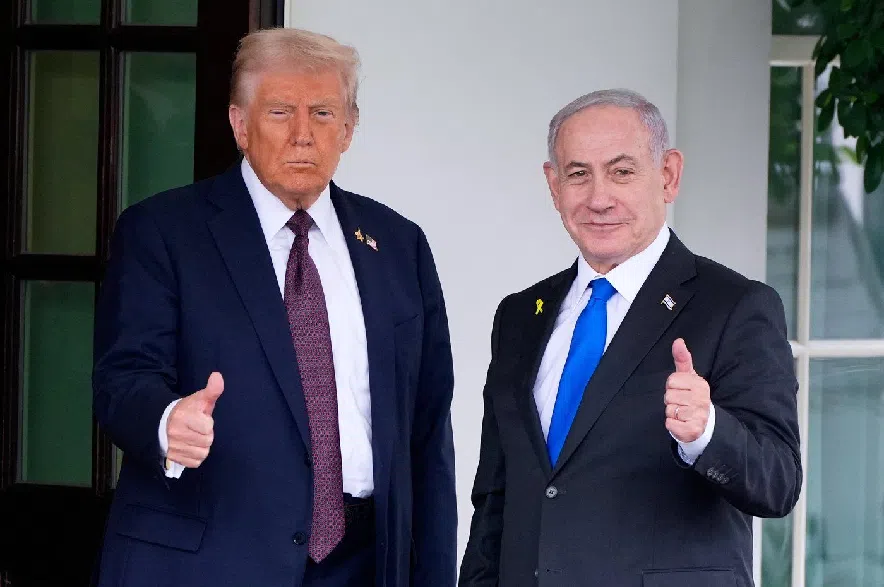CAIRO (AP) — Much remains unknown about U.S. President Donald Trump’s 21-point peace plan for Gaza. But one difference stands out from previous ceasefire proposals: For the first time, it tries to outline the key question of how the territory will be ruled after the war.
There are provisions that could be rejected by either Israel or Hamas. Israeli Prime Minister Benjamin Netanyahu is meeting Trump at the White House on Monday to discuss the plan.
Read more:
- Jobs minister urges Canada Post to table new offer to striking union
- Suspect in Charlie Kirk assassination case faces a court hearing
- Protesters demand body cameras after fatal shooting of 15-year-old Nooran Rezayi
For Hamas, the plan means surrender. Not only would the militant group no longer govern Gaza – a concession it has said it is willing to make. It also would have to disarm, something it has so far rejected.
For Israel, it would mean not having direct security control over the Gaza Strip, which Netanyahu has said Israel wants to maintain. But more importantly, the plan provides for the West Bank-based Palestinian Authority to eventually govern Gaza, which Netanyahu and his hard-line allies resoundingly reject.
It also hints at a process that could lead to the creation of a Palestinian state – also rejected by Israel.
For the near future, the plan envisions a sort of international governance of Gaza. An international security force, likely largely made up from Arab countries, would deploy, and an international committee would oversee an interim administration of Palestinian technocrats who would run day-to-day affairs.
There is still no public text of the proposal, making it hard to judge its provisions. Four Arab officials provided The Associated Press with the outlines of the plan, on condition of anonymity because the text has not been finalized. All cautioned that the broad outlines could still change and that many details still must be hammered out – all potential pitfalls that could cause the plan to fall apart.
Here is what we know so far.
The ceasefire
The plan calls for all hostilities to immediately end. Within 48 hours, Hamas would release all hostages it still holds, living or dead. The militants still hold 48 hostages — 20 of whom are believed by Israel to be alive.
In return, Israel would free hundreds of Palestinian prisoners, including some serving life sentences, as well as the bodies of other Palestinians held by Israel.
Israel would also carry out a phased troop withdrawal from the Gaza Strip.
But much remains vague. In two previous ceasefire deals, it took months to hammer out the timing and number of hostage and prisoner releases.
Also, the extent and timing of the Israeli withdrawal is not defined. Hamas has said it will not release all its hostages unless it receives a “clear declaration” the war will end and Israel will leave Gaza completely.
Israel has previously refused to commit to a full withdrawal, saying it wants to keep control of the Philadelphi Corridor, a strip of land on Gaza’s southern border with Egypt, to prevent weapons smuggling. It has also spoken of keeping a buffer zone inside Gaza, though it is not clear if it will stick to that demand.
The fate of Hamas and postwar Gaza
Hamas would have no part in administering Gaza, and all its military infrastructure — including tunnels — would be dismantled. Members who pledge to live peacefully would be granted amnesty, and those who wish to leave Gaza would be allowed to.
The international security force would ensure Hamas’ disarmament and keep order. It would also train Palestinian police to take over law enforcement. Mediator Egypt has said it is training thousands of Palestinian police to deploy to Gaza.
Meanwhile, humanitarian aid would be allowed to flow into Gaza in large amounts and would be run by “neutral international bodies,” including the U.N. and the Red Crescent. It is unclear whether the Gaza Humanitarian Fund, a controversial alternative food distribution system backed by Israel and the U.S., would continue to operate.
The plan also specifies that Palestinians will not be expelled from Gaza, and that there will be an international effort to rebuild the territory for Palestinians.
In normal cases, that might not need spelling out. But Palestinians have feared mass expulsion after both Trump and the Israeli government spoke of pushing out Gaza’s population – ostensibly in a “voluntary” manner – and rebuilding the strip as a sort of international real estate venture.
The interim administration of Palestinian technocrats would run day-to-day affairs in Gaza. But the plan also has a vague provision for an “international committee,” possibly headed by the United States, that would “watch its work.” Former British Prime Minister Tony Blair is working on a plan for international administration of Gaza for a transitional period.
The committee would also supervise funding of reconstruction, a role that could give it enormous power over governing Gaza since that is the biggest task facing the territory, almost completely destroyed by Israel’s campaign.
The Palestinian Authority and statehood
During this interim administration, the Palestinian Authority would undergo reforms so it can eventually take over governing Gaza.
The plan appears to intentionally avoid direct talk of eventual Palestinian statehood. Instead, it says the U.S. will facilitate talks between Israelis and Palestinians for “a long-term framework for peaceful coexistence.”
Still, the proposal does not rule out statehood and could build momentum toward it. By agreeing to it, Israel could commit itself to resuming peace talks with the Palestinians for the first time in more than a decade.
The response so far
Arab countries appear to back the outline. The leaders of Egypt and the United Arab Emirates met Monday in Cairo and expressed their support, saying the initiative “paves the way for achieving a lasting and comprehensive peace in the region.”
Hamas officials say they have been briefed on the outlines of the plan. But they aren’t responding until they see the finalized proposal.
Hamas has so far rejected disarmament, saying it has a right to resist until Israeli occupation of Palestinian lands ends.
Ahead of his White House meeting on Monday, Netanyahu said he and Trump were working on the proposal. “It’s not been finalized yet, but we’re working with President Trump’s team, actually as we speak, and I hope we can — we can make it a go,” he told Fox News Sunday’s “The Sunday Briefing.”
Netanyahu also faces pressure from his own ultra-nationalist coalition allies.
Finance Minister Bezalel Smotrich, who is part of Netanyahu’s security cabinet, published a list of his “red lines” on X on Monday, in a warning to Netanyahu ahead of his meeting with Trump.
Smotrich is one of the more vocal members of the right-wing bloc of Netanyahu’s coalition who have previously threatened to leave the government if Netanyahu halts the war in Gaza. Even if these parties do quit, centrist politicians have vowed to give Netanyahu the support he needs to prevent his government from collapsing and for a ceasefire to be approved.
Smotrich said there must be no involvement of the Palestinian Authority in Gaza, “neither today nor in the future, neither explicitly nor implicitly.” He also said there must be no mention of a Palestinian state, “even implicitly.”
“The idea of a Palestinian state must be removed from the table forever,” Smotrich wrote.











